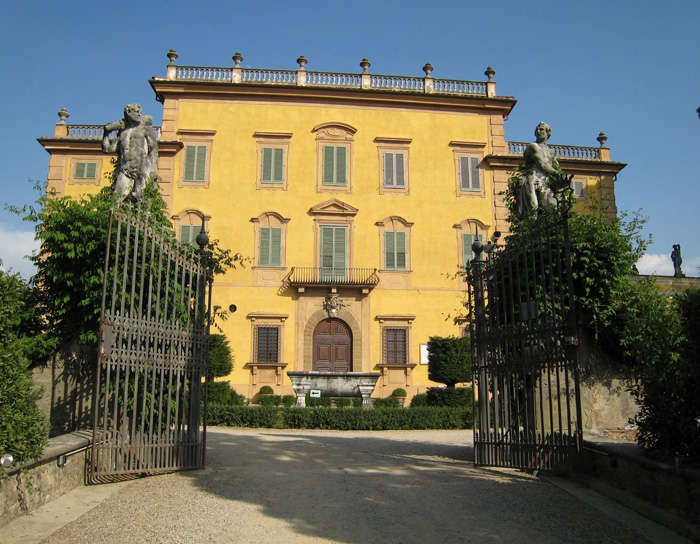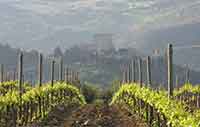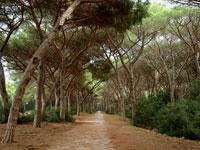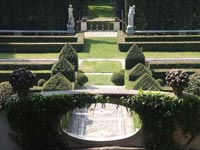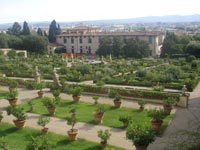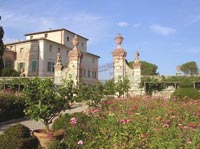
Villa Medicea La Petraia
In the first half of XVIth century, the Medici became the owners of this mansion, which then was characterized by a typical medieval design. Following a project by Buontalenti, a good number of modifications were effected, until the works were completed, by the end of the XVIth century. The structure has a square base, it is two stories high and it has maintained the ancient tower.
The entrance is immersed in a wide surrounding garden. These gardens, on three levels, mirror the typical XVIth century layout, although a few modifications were included during the XIXth century From the Italian garden you climb up to the middle fishpond, and then you reach the suspended level of the Figurine, so called because of the fountain depicting Florence’s Venus.
The entrance portal is located on the southern edge, and the symbol of the Medici-Lorena hangs over it. From the hallway you can reach the central court, decorated with frescoes by Daddi and by Volterrano.
The glass coverings in the courtyard, turned into a ballroom, and the Imperial style furnishings in the halls were ordered by Vittorio Emanuele II di Savoia. Among the major elements of interest we will remember the collection of social games (Hall of games) and the small study, hosting a bronze statue by Giambologna.
Once the crowning of the fountain on the Level of the Figurine, the statue depicts Florence’s Venus drying her hair from the waters of Arno and Mugnone. The English park on the hill behind the mansion is also worthy of a visit.
Villa Medicea della Petraia, Castello, Via della Petraia 40, Firenze | (055 452691)
Giardino dei Semplici
The Orto Botanico di Firenze (2.3 hectares), also known as the Giardino dei Semplici, the "Garden of simples",[1] is a botanical garden maintained by the University of Florence. The Botanical Gardens of Florence is one of the oldest Botanical Gardens in the world, together with Padua and Pisa.
The garden was established on December 1, 1545, by Cosimo I de' Medici, Grand Duke of Tuscany, and is Europe's third oldest, behind the Orto Botanico di Pisa and the Orto Botanico di Padova. It was first laid out by landscape gardener Niccolò Pericoli to a botanical system and plantings chosen by Luca Ghini, and rose to prominence under Cosimo III, with Pier Antonio Micheli as its director. As was typical of early European botanical gardens, its prime interest was in medicinal plants. However, as in 1753 the Società Botanica was formed, the garden's focus turned to "experimental agriculture" and its layout was revised accordingly. The garden grounds opened to the public in the mid-19th century, at about the same time that its glass houses (1694 m²) were constructed.
Villa Medici at Fiesole, near Florence, is one of the oldest Renaissance residences with a garden and is also one of the best preserved, but at the same time one of the least well known. While most of the villas dating back to the same period, such as Cafaggiolo and Trebbio, stand at the centre of agricultural concerns, Villa Medici had no connections at all with farming life.
The villa was built during the mid 15th century when Cosimo de' Medici the Elder employed Michelozzo di Bartolomeo to design it for his second son, Giovanni. Intended to be a setting for intellectual life rather than a working Villa, Villa Medici was constructed to be a demonstration of aesthetic and ideological values. It owes its fame to Lorenzo il Magnifico who inherited the property in 1469 following the untimely death of his uncle. The new master of the house turned the residence into a gathering place for artists, philosophers and men of letters such as Marsilio Ficino, Pico della Mirandola and Angelo Ambrogini, known as Poliziano. The quadrangular building is a typical 15 C edifice, with square pietra serena windows and broad loggias looking out over the surroundings.
The villa remained the property of the Medici until 1671.
The geographical position of the villa on gently sloping land suggested the layout of the garden on three terraces. The first of these, at the end of an avenue lined with cypress trees that runs underneath a holm-oak wood, has large rectangular lawns with potted lemon trees. The villa's piano nobile looks out onto this part of the garden. The second terrace is overlooked by the rear of the building and is reached by an indoor staircase. This, the least heavily altered part of the garden, has flower beds lined with box hedges with a large fountain in the centre, and is laid out in the shade of large magnolia trees. The third terrace, created between 1911 and 1923 by Cecil Pinsent and Geoffrey Scott [1] is aligned longitudinally with the first, but is 11-12 m lower down. It is laid out in the Italian style, with a fine pergola positioned mid-way between the two levels. Lady Sybil's daughter and heiress, Iris Origo, later employed Cecil Pinsent for the development of the garden at La Foce, her property in the Crete Senesi near Montepulciano.
Villa Poggio Torselli, near San Casciano Val di Pesa, is one of the largest and most elegant residences in the area of the San Casciano Hills, near Florence. Known in the past as the “queen of all villas”, it appeared on record as early as 1427 bearing the name of “Poggio Torselli”.
It was the property of some of the most remarkable patrician families in Tuscany: Macchiavelli, Corsini, Strozzi, Antonori, Capponi and Orlandini, who owned the villa until 1722. The "Season s' Garden", created in the 18th century offers the most astonishing image of its rebirth in April, with the scented blossom of the splendid bulbous plants: narcissus, tulips, hyacinths and many others spring plants such as, in particular, the firittilaria also known as "imperial crown" because of the orange tuft of bell-shaped, pendolous flowers surmounting the bottom of the stem that, thanks to its charme deserved one of the most clamorous nobilty's title of Villa Poggio Torselli.
But, not less perfumed and gorgeous is the exotic summer of the garden, crowned by plants of dahlia, sage, multicolour clematis and Indian giant ibiscus. And, in every season, the entire garden is surrounded by the golden crown of 120 secular lemon trees.
The Villa di Catignano was built at the end of XVII° century by the ancestor of the currents proprietors, Quinto Settano, pseudonym of Monsignor Lodovico Sergardi, a writer and a lover of the arts. The small borough already existed in 1500 with the name of "Clatinianum" as a property of Sergardi family. Nowadays the Villa, overlooking a beautiful italian garden, decorated with statues representing the four season, and the medievaltowers of Siena in the distance, welcomes guests who appreciate historical sites and suggestive atmospheres.
Villa I Tatti
Villa I Tatti in Settignano was home to Bernard Berenson, the Lithuanian Jew who became America's most illustrious critic and connoisseur of Renaissance art. For 50 years it was a mecca for intellectuals and collectionists from the world over. Today the art collection and library serve as a research facility for Harvard University.
In 1900, Bernhard Berenson bought a villa in the Tuscan hills of Settignano, outside Florence. Villa I Tatti subsequently would be forever associated with Berenson. The gardens of the Villa I Tatti were created by the English landscape architect Cecil pinsent and Geoffrey Scott.
The newly married art historians Bernard and Mary Berenson made their home at the Villa I Tatti near Florence in 1900. In the following years Mary, supervised the rebuilding of the villa and the creation of its elegant gardens. The Berensons pursued their work at I Tatti over a period of nearly six decades, and here they entertained a remarkable circle of friends :art historians ( Kenneth Clark, John Walker, John Pope-Hennessy), writers (Edith Wharton, Alberto Moravia), political thinkers (Walter Lippman, Gaetano Salvermini), musicians (Yehudi Menuhin) and countless other visitors from every part of the world. At I Tatti Bernard Berenson assmbled a choice collection of Renaissance art, including works by Giotto, Sassetta, Domenico Veneziano, and Lorenzo Lotto. He also formed a prodigious art historical research library and photograph collection. When he died in 1959, he bequeathed the house, its contents, and the gardens to Harvard University as a Center for Renaissance Studies.
|

